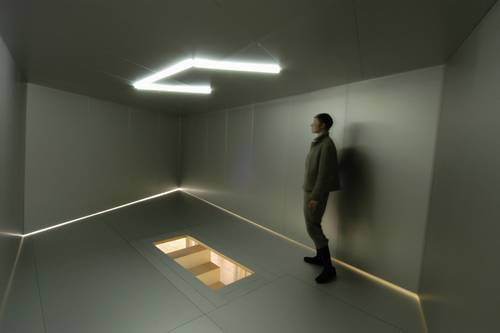Carsten Höller
06 May - 02 Jul 2005
Carsten Höller
DIE INNERE KONKURRENZ
May 6 – July 2, 2005
The reopening of the gallery with the fourth solo exhibition by Carsten Höller marks the end of our five-month reconstruction phase. The architectural changes completed during this period were overseen by the London architects Caruso St. John whose design has expanded the former exhibition space while adding another room. Carsten Höller will be showing two large installations which question what we take for granted in the perception of ourselves and our surroundings and in the relationships we establish with them.
In the front room, the viewer can enter the Trapezoid Swinging Room (2005), although one has to crouch to reach a staircase in the base of the structure leading up into the room. As the walls are made from Alucobond and the floor is covered with aluminum plate, one finds oneself in a continuous metal body, illuminated by a single UV-neon lamp shedding bluish light. Since the four walls and the ceiling of the Trapezoid Swinging Room are suspended from the ceiling of the exhibition space and do not touch the floor, the construction moves very easily and swings when lightly touched. Visitors, attempting to offset the movement of the room by moving their bodies, experience dizziness, augmented through the trapezoid construction with its inclined walls and ceiling. Children under five years of age tend to fall down, since they orient themselves almost exclusively through sight. With older children and adults, the proprioception dependant on gravitation competes with visual information, and their sense of balance is disturbed.
In the smaller adjoining room, Three-Fold Delayed Infrared Room (2004/05) also creates a conflict between seeing and sensing. People in the room are filmed with three infrared cameras. In this closed-circuit system, the images are projected onto the wall via three projectors, albeit with a slight time delay that slowly increases and decreases. Since the temporal dynamic and amplitude of the three projections differ, viewers see themselves in three different times that never synchronize. They tend to believe in the projections they see more than to trust their sense of time passing. Invariably one identifies with the projection that comes closest to real time, only until this projection's delays increase, whereupon one turns to yet another projection that seems close to real time. One experiences a triply split present with a constantly shifting division in relation to one's own self.
Carsten Höller will be exhibiting a work related to the Trapezoid Swinging Room at the Reykjavik Arts Festival (14.5.-5.6.2005) and collaborating with Miriam Bäckström for the Swedish part of the Nordic Pavilion at the upcoming Venice Biennale (12.6.-6.11.05).
For further information and for images, please contact
Barbara Schindler, schindler@estherschipper.com, tel. +49-30-43739359 or
Annika von Taube, taube@estherschipper.com, tel. +49-30-28390139
DIE INNERE KONKURRENZ
May 6 – July 2, 2005
The reopening of the gallery with the fourth solo exhibition by Carsten Höller marks the end of our five-month reconstruction phase. The architectural changes completed during this period were overseen by the London architects Caruso St. John whose design has expanded the former exhibition space while adding another room. Carsten Höller will be showing two large installations which question what we take for granted in the perception of ourselves and our surroundings and in the relationships we establish with them.
In the front room, the viewer can enter the Trapezoid Swinging Room (2005), although one has to crouch to reach a staircase in the base of the structure leading up into the room. As the walls are made from Alucobond and the floor is covered with aluminum plate, one finds oneself in a continuous metal body, illuminated by a single UV-neon lamp shedding bluish light. Since the four walls and the ceiling of the Trapezoid Swinging Room are suspended from the ceiling of the exhibition space and do not touch the floor, the construction moves very easily and swings when lightly touched. Visitors, attempting to offset the movement of the room by moving their bodies, experience dizziness, augmented through the trapezoid construction with its inclined walls and ceiling. Children under five years of age tend to fall down, since they orient themselves almost exclusively through sight. With older children and adults, the proprioception dependant on gravitation competes with visual information, and their sense of balance is disturbed.
In the smaller adjoining room, Three-Fold Delayed Infrared Room (2004/05) also creates a conflict between seeing and sensing. People in the room are filmed with three infrared cameras. In this closed-circuit system, the images are projected onto the wall via three projectors, albeit with a slight time delay that slowly increases and decreases. Since the temporal dynamic and amplitude of the three projections differ, viewers see themselves in three different times that never synchronize. They tend to believe in the projections they see more than to trust their sense of time passing. Invariably one identifies with the projection that comes closest to real time, only until this projection's delays increase, whereupon one turns to yet another projection that seems close to real time. One experiences a triply split present with a constantly shifting division in relation to one's own self.
Carsten Höller will be exhibiting a work related to the Trapezoid Swinging Room at the Reykjavik Arts Festival (14.5.-5.6.2005) and collaborating with Miriam Bäckström for the Swedish part of the Nordic Pavilion at the upcoming Venice Biennale (12.6.-6.11.05).
For further information and for images, please contact
Barbara Schindler, schindler@estherschipper.com, tel. +49-30-43739359 or
Annika von Taube, taube@estherschipper.com, tel. +49-30-28390139

